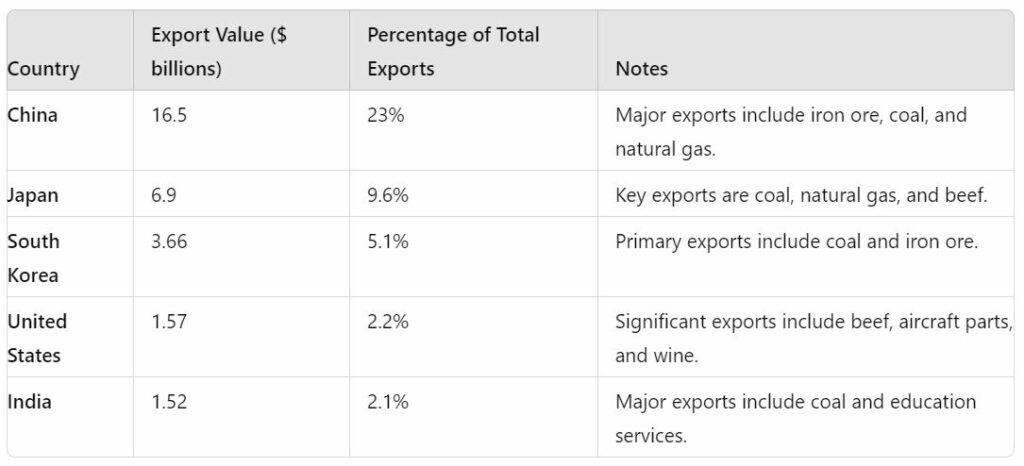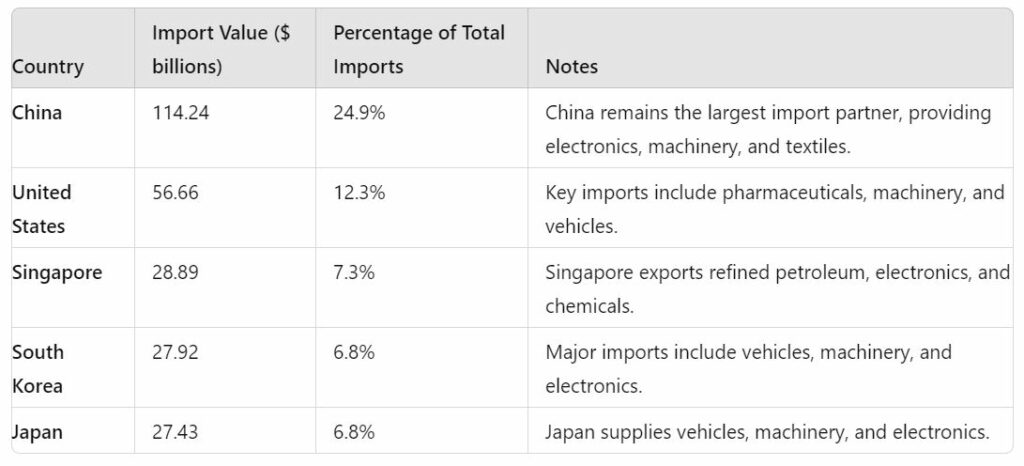
Australia’s trade landscape is a dynamic and complex network of established and emerging partnerships that highlight the nation’s strategic economic positioning. This detailed analysis covers Australia’s top export and import partners, trade deficits and surpluses, continental trade distribution, and the various initiatives and strategies shaping its trade policies.
 Top Export Partners
Top Export Partners
- China
- Value: AUD 16.5 billion
- Percentage of Total Exports: 23%
- China remains Australia’s largest export partner. Key exports include iron ore, coal, and natural gas. China’s demand for these resources fuels its industrial growth, making this partnership mutually beneficial.
- Japan
- Value: AUD 6.9 billion
- Percentage of Total Exports: 9.6%
- Japan is a major destination for Australian exports, primarily receiving coal, natural gas, and beef. The strong economic ties between the two countries are bolstered by their shared commitment to trade and investment.
- South Korea
- Value: AUD 3.66 billion
- Percentage of Total Exports: 5.1%
- South Korea imports significant quantities of coal and iron ore from Australia. This relationship underscores South Korea’s industrial reliance on Australian resources.
- United States
- Value: AUD 1.57 billion
- Percentage of Total Exports: 2.2%
- Key exports to the United States include beef, aircraft parts, and wine. The diverse range of products highlights the complementary nature of the trade relationship.
- India
- Value: AUD 1.52 billion
- Percentage of Total Exports: 2.1%
- Major exports to India include coal and education services. This partnership is a blend of resources and specialized services, reflecting the evolving needs of both nations.
 Top Import Partners
Top Import Partners
- China
- Value: AUD 114.24 billion
- Percentage of Total Imports: 24.9%
- China remains Australia’s largest import partner, providing a wide range of goods including electronics, machinery, and textiles.
- United States
- Value: AUD 56.66 billion
- Percentage of Total Imports: 12.3%
- Key imports from the United States include pharmaceuticals, machinery, and vehicles.
- Singapore
- Value: AUD 28.89 billion
- Percentage of Total Imports: 7.3%
- Singapore exports refined petroleum, electronics, and chemicals to Australia.
- South Korea
- Value: AUD 27.92 billion
- Percentage of Total Imports: 6.8%
- Major imports from South Korea include vehicles, machinery, and electronics.
- Japan
- Value: AUD 27.43 billion
- Percentage of Total Imports: 6.8%
- Japan supplies vehicles, machinery, and electronics to Australia.
Trade Deficits and Surpluses
Australia’s trade balance reflects its diverse economic interactions, achieving a substantial overall trade surplus driven by strong export relationships with countries like China (AUD 80.7 billion), Japan (AUD 29.1 billion), and India (AUD 12.7 billion), primarily due to high exports of iron ore, coal, and natural gas. However, it also faces significant trade deficits with the United States (AUD 25.9 billion), Germany (AUD 14.7 billion), and Thailand (AUD 12.5 billion), mainly from imports of pharmaceuticals, machinery, and vehicles. This interplay of surpluses and deficits underscores Australia’s pivotal role in global trade, balancing its export strength in natural resources with the import of advanced manufactured goods and technology.
 Continental Trade Distribution
Continental Trade Distribution
A significant portion of Australia’s trade is concentrated within Asia, with around 63% of exports and 58% of imports involving Asian countries. North America follows with notable trade volumes, representing 9% of exports and 14% of imports. Europe also plays a key role in Australia’s trade, accounting for 15% of exports and 18% of imports. This trade distribution underscores Australia’s strategic economic connections across multiple continents, highlighting its integrated role in global trade networks
Emerging Markets and New Partnerships
Australia is continually seeking to diversify its trade portfolio by exploring and establishing connections with emerging markets. Countries such as Vietnam, Indonesia, and Brazil have been identified as strategic partners with significant growth potential. These markets offer opportunities for expanding exports of minerals, agricultural products, and education services, thereby reducing reliance on traditional trade partners and enhancing economic resilience.
Sustainable Trade Practices
The shift towards sustainable trade practices is becoming increasingly prominent within Australia’s trade strategy. Emphasizing environmental responsibility, Australia is adopting measures to ensure that its mining, agricultural, and manufacturing sectors operate sustainably. This includes adhering to international environmental standards, investing in renewable energy resources, and promoting the export of eco-friendly products. Maintaining sustainable practices not only preserves natural resources but also meets global consumer demand for ethical products.
Technological Innovations
Technological advancements are playing a pivotal role in transforming Australia’s trade landscape. Cutting-edge technologies such as blockchain, artificial intelligence, and the Internet of Things (IoT) are being integrated into supply chain management to enhance transparency, efficiency, and security. Innovations in logistics and data analytics are helping businesses optimize their operations and respond swiftly to market changes, thereby keeping Australia competitive in the global market.
Government Initiatives
The Australian government continues to support international trade through a series of initiatives aimed at boosting export capacity and market access. Programs such as the Export Market Development Grants (EMDG) and the Free Trade Agreements (FTA) are designed to assist businesses in expanding their overseas presence. Moreover, government-led trade missions and partnerships with international trade organizations contribute to fostering an environment conducive to business growth, ensuring that Australian companies remain significant players in the global economy.
 Conclusion
Conclusion
Australia’s trade portfolio is a testament to its adaptive economic strategies and global integration. By maintaining strong relationships with key partners like China, the United States, and Japan, Australia capitalizes on its natural resources while fostering growth in high-value sectors such as education and technology. The focus on sustainable practices and technological advancements demonstrates Australia’s commitment to a resilient and dynamic economy. Government initiatives further support this framework, helping Australian businesses expand their global footprint and stay competitive in an evolving market. As Australia navigates the complexities of global trade, it is well-positioned to leverage its strategic partnerships and innovative approaches to ensure long-term economic prosperity.




 Top Export Partners
Top Export Partners Top Import Partners
Top Import Partners Continental Trade Distribution
Continental Trade Distribution Conclusion
Conclusion



